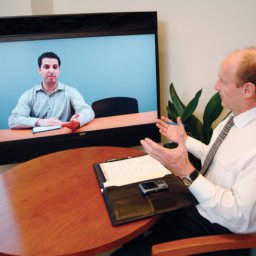Original Post by Dennis Collins
Video conferencing is shifting from a workplace rarity to an essential collaboration tool. But while many of us use  FaceTime, Skype and other video conferencing tools in our personal lives without hesitation, using video technology in the workplace can make employees feel uneasy without the right training.
FaceTime, Skype and other video conferencing tools in our personal lives without hesitation, using video technology in the workplace can make employees feel uneasy without the right training.
According to our recent study, this aversion to professional video conferencing stems from multiple factors – general unease with public speaking, nerves about being on camera, or even the anticipation of running into technical difficulties. To date, employers haven’t done enough to help staff overcome these worries; in fact, only 23 percent of employees report receiving video etiquette training.
If employees are intimidated by the idea of video conferencing, they’re ill equipped to participate productively in video meetings – which can have long-term ramifications for their employers. To help workers acclimate to this medium, organizations must reprioritize both technical and soft-skill video training.
Here are four recommendations for creating a curriculum that takes the angst out of video conferencing:
1. Use a Buddy System for Video Call Dress Rehearsals
Throwing employees into video calls with clients or supervisors, without any previous training, only exacerbates video anxiety. Instead, employers should match workers with partners on other teams or departments to conduct a few video conference dress rehearsals.
These practice runs serve as a safe space for employees to familiarize themselves with the technology and interface, as well as the sensation or seeing and hearing themselves on the small screen.
2. Double Check the Scenery of your Video Feed
Unlike with web or audio conference calls, an attendee’s physical background shouldn’t be an afterthought during video meetings. Anything behind or around you could wind up in the camera’s view, whether it’s a pile of dirty laundry, a NSFW poster or a sleeping pet. Lighting matters too – finding the right mix of natural and overhead light to avoid on-screen shadows or over-saturation can make a big difference.
Consider providing employees with a brief scenery checklist, or another small reminder to assess their environment before dialing into a call.
3. Mind the Mic
Through a web camera and microphone, even the delicate sound of shuffling papers can come through as loud interference. Along the same lines, when a video attendee types on the same device they’re calling from, the tapping is enough to drown out an otherwise productive conversation.
Make sure your employees are well versed in common sound etiquette tips (e.g., closing background Internet tabs to avoid interruptions from auto-play ads), and that they know the correct process to mute and unmute their own microphones.
 4. Train for Home and Office Use of Video Technology
4. Train for Home and Office Use of Video Technology
Even when employees know the right steps to follow when video conferencing from the office, the process may look different when connecting from a remote location. There may be a handful of nuances between what users do when dialing in from a conference room network versus their personal laptop on their home network (not to mention, the IT team isn’t a few steps away to help save the day).
Comprehensive video conferencing education should prep employees for any and all of these scenarios.
Sometimes it's not just about your comfort level, it could be the conferencing tech you're using. Click here for more info on what Momentum Conferencing has to offer!



